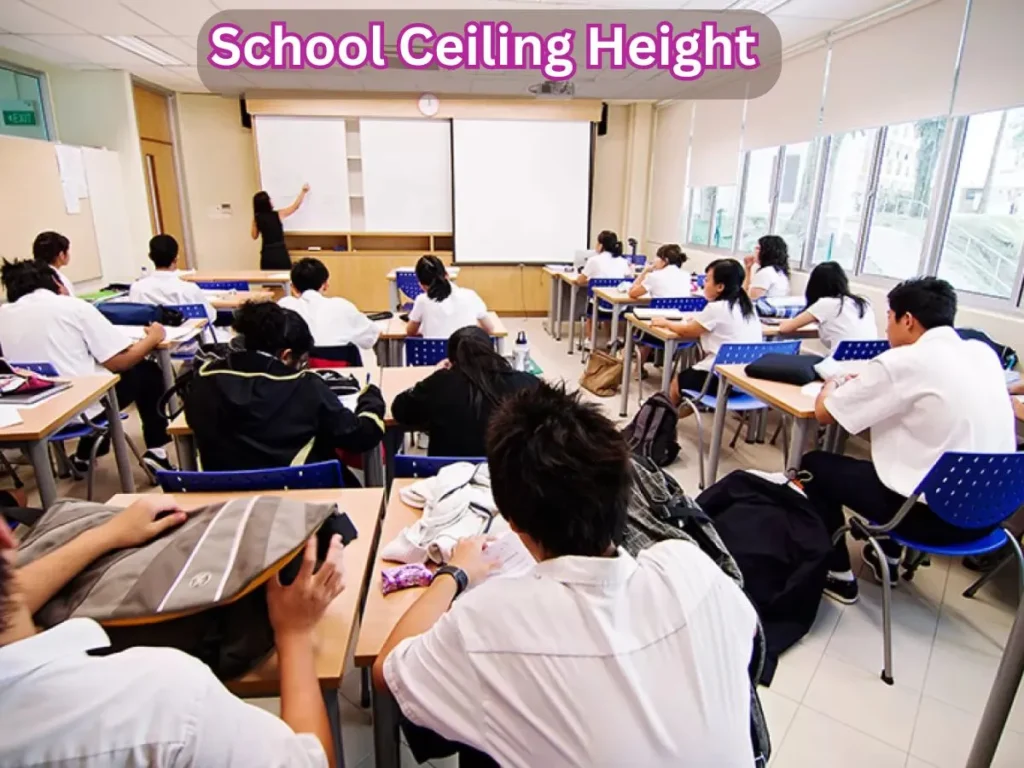When we reflect on what makes a high-quality classroom, school ceiling height might not immediately come to mind.
Yet, it plays a pivotal role in shaping the learning experience.
From acoustics to air quality and even student mood, the height of school ceilings affects many aspects of the educational environment.
How can the peak of a faculty ceiling revolutionize the learning environment?
Taller ceilings enhance school room acoustics, air excellent, and lights, creating a more conducive and galvanizing space for students.
This layout choice enhances attention, comfort, and standard instructional enjoyment.
Let’s discover why this reputedly simple layout detail is so essential.
Acoustics Clear Communication Matters
Imagine a lecture room wherein each word spoken is crystal clear.
High ceilings could make this possible.
In spaces with taller ceilings, sound waves travel greater successfully, lowering echoes and growing a greater balanced acoustic surroundings.
This enables college students to hear their instructors absolutely, that is vital for effectively gaining knowledge of.
Lower ceilings, however, can trap sound and purpose distortions, making it tougher for students to concentrate and apprehend their training.
Air Quality Breathing Easy

Good air quality is critical for an effective lecture room.
Tall ceilings make a contribution to higher ventilation by permitting air to circulate more freely. This enables the air to sparkle and reduces the awareness of pollution and allergens.
In contrast, classrooms with decreasing ceilings can emerge as stuffy and uncomfortable, which can affect students’ concentration and standard health.
A well-ventilated space with sufficient ceiling height promotes a greater nice and efficient learning environment.
Lighting Bright Ideas
Lighting could make or wreck a classroom’s environment.
Higher ceilings offer extra alternatives for putting light furnishings, which enables attain even and adequate illumination.
This is particularly vital for activities like studying and writing.
With a nicely-lit classroom, college students can focus higher and experience much less eye pressure.
Tall ceilings also permit for the use of stylish and powerful lighting answers, enhancing both capability and aesthetics.
Space Perception The Psychological Effect

The manner we perceive space can significantly have an effect on our temper and motivation. Taller ceilings create a feel of openness and freedom that can undoubtedly impact students’ attitudes and creativity.
Feeling less restricted in a spacious room can enhance college students’ engagement and reduce stress.
Conversely, decreasing ceilings could make a room experience cramped and restrictive, which might affect students’ consolation and enthusiasm for getting to know each other.
Design Consideration Balancing Act
While excessive ceilings provide several advantages, they also come with sensible concerns. For instance, retaining a snug temperature in a room with tall ceilings can be more challenging and probably extra expensive.
Schools must cautiously balance the blessings of advanced acoustics, air quality, and lighting fixtures with the costs of heating and cooling.
Thoughtful design can help obtain this balance, making sure that the advantages outweigh any drawbacks.
Innovative Examples Schools Leading the Way
Many current faculties have embraced the advantages of excessive ceilings.
These schools often report progressed student performance and pleasure.
For instance, a few instructional establishments have integrated tall ceilings into their design to decorate acoustic exceptional and create an extra inviting surroundings.
These fulfillment stories highlight how high ceilings can make contributions to a more effective and enjoyable learning.
Practical Tips for Implementation

When designing or renovating a study room, take into account the effect of ceiling top on the general surroundings.
For new buildings, incorporating excessive ceilings may be part of a method to create a more attractive and powerful mastering space.
For existing classrooms, there are approaches to improve the environment despite the fact that the ceilings aren’t in particular excessive.
Good lights, powerful air flow, and sound-soaking up substances can assist mitigate some of the challenges associated with decreasing ceilings.
FAQ’s
- Why are excessive ceilings important in lecture rooms?
High ceilings improve acoustics, air first-rate, and lighting, creating a more snug and effective mastering environment.
- How do tall ceilings affect school room acoustics?
Tall ceilings reduce echoes and distribute sound more calmly, enhancing college students’ capacity to hear and apprehend their teachers.
- What impact does ceiling top have on pleasant air?
Higher ceilings permit for better air circulation and ventilation, lowering stuffiness and enhancing basic air high-quality in the classroom.
4.Can high ceilings improve lecture room lighting?
Yes, they offer greater alternatives for light fixture placement, resulting in better and extra even illumination at some stage in the room.
- Do higher ceilings have an impact on college students’ mood and engagement?
Yes, they invent a sense of openness and area, that may improve college students’ motivation and reduce emotions of confinement
Conclusion
School Ceiling height might also look like a minor detail in faculty layout, but its impact on studying environments is extensive.
From improving acoustics and air satisfaction to influencing lights and pupil belief, high ceilings make contributions to a greater powerful and fun instructional enjoyment.
As colleges preserve to conform, taking note of details like ceiling peak can make a massive difference in growing areas that guide both teaching and gaining knowledge of.
By knowledge and leveraging the benefits of ceiling top, instructional establishments can foster environments that now not best decorate educational overall performance however additionally promote typical well-being and delight for college students and instructors alike.
You Can Also read it
The High Price of Ant Farms What Drives the Cost?

